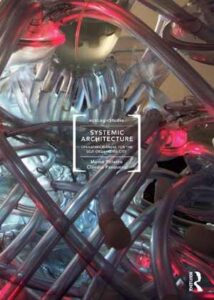نام کتاب: Systemic Architecture – Operating Manual For The Self Organizing City
نویسنده: Marco Poletto و Claudia Pasquero
ویرایش: ۱
سال انتشار: ۲۰۱۲
کد ISBN کتاب: ۹۷۸۰۴۱۵۵۹۶۰۷۷, ۰۴۱۵۵۹۶۰۷۶, ۹۷۸۰۴۱۵۵۹۶۰۸۴, ۰۴۱۵۵۹۶۰۸۴,
فرمت: PDF
تعداد صفحه: ۲۷۲
حجم کتاب: ۱۵ مگابایت
کیفیت کتاب: OCR
انتشارات: Routledge
Description About Book Systemic Architecture – Operating Manual For The Self Organizing City From Amazon
This is a manual investigating the subject of urban ecology and systemic development from the perspective of architectural design. It sets out to explore two main goals: to discuss the contemporary relevance of a systemic practice to architectural design, and to share a toolbox of informational design protocols developed to describe the city as a territory of self-organization.
Collecting together nearly a decade of design experiments by the authors and their practice, ecoLogicStudio, the book discusses key disciplinary definitions such as ecologic urbanism, algorithmic architecture, bottom-up or tactical design, behavioural space and the boundary of the natural and the artificial realms within the city and architecture.
A new kind of “real-time world-city” is illustrated in the form of an operational design manual for the assemblage of proto-architectures, the incubation of proto-gardens and the coding of proto-interfaces. These prototypes of machinic architecture materialize as synthetic hybrids embedded with biological life (proto-gardens), computational power, behavioural responsiveness (cyber-gardens), spatial articulation (coMachines and fibrous structures), remote sensing (FUNclouds), and communication capabilities (Ecological Footprint Grotto).
Supporting the authors’ own essays and projects are contributions from key innovators in contemporary architecture and urban design: Michael Batty, Andrew Hudson-Smith, Michael Weinstock and Patrik Schumacher.
درباره کتاب Systemic Architecture – Operating Manual For The Self Organizing City ترجمه شده از گوگل
این کتابچه راهنمای بررسی موضوع بوم شناسی شهری و توسعه سیستمیک از منظر طراحی معماری است. هدف این تحقیق بررسی دو هدف اصلی است: بحث در مورد ارتباط معاصر یک روش سیستمی با طراحی معماری ، و به اشتراک گذاشتن یک جعبه ابزار از پروتکل های طراحی اطلاعاتی که برای توصیف شهر به عنوان قلمرو خود سازماندهی تهیه شده است.
این کتاب با گردآوری نزدیک به یک دهه آزمایش طراحی توسط نویسندهو عملکرد آنها ، ecoLogicStudio ، در مورد تعاریف کلیدی نظریه نظیر شهرسازی اکولوژیک ، معماری الگوریتمی ، طراحی از پایین به بالا یا تاکتیکی ، فضای رفتاری و مرز قلمروهای طبیعی و مصنوعی بحث می کند. در داخل شهر و معماری
نوع جدیدی از “شهر جهانی در زمان واقعی” در قالب یک کتابچه راهنمای طراحی عملیاتی برای مجموعه معماری های اولیه ، انکوباسیون باغ های تک هسته ای و کدگذاری رابط های اولیه نشان داده شده است. این نمونه های اولیه معماری ماشین به عنوان ترکیبی ترکیبی با زندگی بیولوژیکی (باغ های تک هسته ای) ، قدرت محاسباتی ، پاسخگویی رفتاری (باغ های سایبری) ، بیان فضایی (coMachines و ساختارهای الیافی) ، سنجش از دور (FUNclouds) و قابلیت های ارتباطی (اکولوژیکی) تحقق می یابد. Footprint Grotto).
حمایت از مقاله ها و پروژه های نویسنده، مشارکت نوآوران اصلی در معماری معاصر و طراحی شهری است: مایکل بتی ، اندرو هادسون-اسمیت ، مایکل وینستاک و پاتریک شوماخر.
[box type=”info”]![]() جهت دسترسی به توضیحات این کتاب در Amazon اینجا کلیک کنید.
جهت دسترسی به توضیحات این کتاب در Amazon اینجا کلیک کنید.![]() در صورت خراب بودن لینک کتاب، در قسمت نظرات همین مطلب گزارش دهید.
در صورت خراب بودن لینک کتاب، در قسمت نظرات همین مطلب گزارش دهید.

